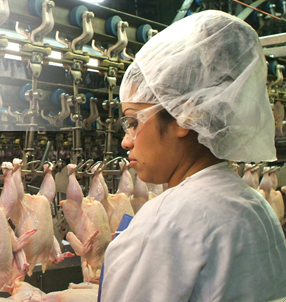American poultry producers used a US International Trade Commission (USITC) hearing in Washington, DC, on January 14 to both express support for the Trans-Pacific Partnership (TPP) and to highlight mixed experiences with past free trade agreement negotiations.
 National Chicken Council (NCC) President Mike Brown, on behalf of NCC and the USA Poultry & Egg Export Council (USAPEEC), delivered testimony addressing the likely economic impact of the TPP on the US poultry sector, should the deal be fully implemented.
National Chicken Council (NCC) President Mike Brown, on behalf of NCC and the USA Poultry & Egg Export Council (USAPEEC), delivered testimony addressing the likely economic impact of the TPP on the US poultry sector, should the deal be fully implemented.
The TPP is trade agreement between Australia, Brunei, Chile, Canada, Japan, Malaysia, Mexico, New Zealand, Peru, Singapore, the United States and Vietnam. Negotiations concluded last November, and now the agreement must be ratified by each country and, in the US, debated and passed by Congress.
Both NCC and USAPEEC have supported TPP, continuing 30 years of ongoing support for free trade and trade liberalization initiatives. Though the poultry industry in the United States has been in support of free trade, the industry’s experience with the results of free trade agreement negotiations has been mixed. During past negotiations, poultry has often been denominated a “sensitive product” and typically receives less-favorable access than other products.
Brown stressed that poultry once again faced mixed results in the TPP negotiations. “Our very frank assessment of the TPP provisions is that this agreement, on its current terms alone, will provide opportunity for moderate improvement for US exports of poultry products in three of the 11 markets,” Brown said.
A key point is the lack of meaningful increases in access for US poultry to Canada.
“While virtually all other commercial sectors have been able to play the NAFTA game for the past three decades, US poultry has been relegated to the sidelines,” he added.
Under TPP, US poultry’s access to the Canadian market will only grow through small increases in quotas over a long period of time rather than truly free trade.
“The TPP was the opportunity to correct a 30-year-old mistake, and very frankly, the results of this negotiation are disappointing in that regard,” Brown told the commission.
Brown also took the opportunity to thank USTR for its work in developing improved sanitary and phytosanitary (SPS) provisions. These could provide the initial boost needed to place more emphasis on SPS in all trade discussions.
As the 2015 outbreak of highly pathogenic avian influenza (HPAI) in the United States showed, SPS barriers could cause great damage to trade. Though the HPAI detections were regional and contained, some trading partners placed bans on poultry from the entire country for much longer than justified. During the first 10 months of 2015, unjustified non-tariff trade restrictions cost the poultry and egg industry over $3.3 billion in lost income.
Brown also pointed out key moderate improvements afforded through TPP.
“Our assessment is that TPP will allow us to make some modest inroads in Japan and hopefully in Vietnam; but we do not believe the TPP, as currently negotiated, will provide our industry with any actual market access in Malaysia,” he stated.
 The United States exported $128 million worth of poultry and poultry products to Japan in 2014. Japan’s tariffs are currently as high as 21.3 percent, or 48 yen per kilogram, whichever is greater (approximately 24.1 percent ad valorem equivalent). Under the TPP agreement, tariffs on all poultry, eggs, and egg products will be eliminated in six to 13 years.
The United States exported $128 million worth of poultry and poultry products to Japan in 2014. Japan’s tariffs are currently as high as 21.3 percent, or 48 yen per kilogram, whichever is greater (approximately 24.1 percent ad valorem equivalent). Under the TPP agreement, tariffs on all poultry, eggs, and egg products will be eliminated in six to 13 years.
The United States exported $92.7 million of poultry and poultry products to Vietnam in 2014. That nation’s tariffs on poultry and poultry meat, currently as high as 40 percent, will be eliminated within 13 years. This includes tariffs on frozen chicken cuts and offal, which will be eliminated in 11 years.
Brown concluded, “We are wholeheartedly supporting TPP, as we did all the other free trade agreements and fully support passage and implementation by Congress.”





